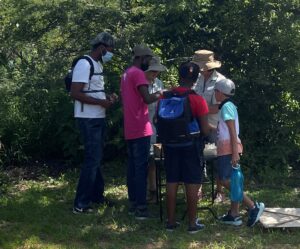The Spider Club of Zimbabwe meet up for an outing into Mabukuwene Nature Reserve on 12th February at 8am before the temperatures started to rise. It was a clear summers day and a small group of enthusiastic kids with their parents came along. One mother was totally terrified of the bush and anything with more than two legs but it was encouraging to see her overcome her fears so her child could join in. As with most spider and bug hunting walks you really don’t need to go far to find anything and after a two hour hunt we have only gone 50m.
The group broke for a tea break and were entertained by Martin Sanderson (Founder of Adventure into Learning) with his story that Mabukuwene as named by Mr Thomas Meikle because this was where he kept his Library (Mabookas)!! After which we went for a walk to the “library” and lookout point and continued the bug hunt.
Many thanks go to the staff of the Entomology and Arachnology department at the Natural history Museum for helping out and the National Trust for granting permission to use their Nature Reserve for this outing.
Spiders, insects, reptiles and other things that were photographed during the morning can be viewed at https://www.inaturalist.org/projects/mabukuwene-nature-reserve where there is project for these and any other records for the Nature reserve can be viewed on INaturalist.
Annotated Checklist Mabukuwene 12th February 2022
Spiders
Neoscona (Hairy filed spiders) make orb-webs at night which are removed early in the morning. These spiders are commonly found during summer in grassland and low vegetation. A number of species have been recovered from Zimbabwe.
Steatoda capensis (False button spiders) make three dimensional webs usually close to the substrate and are frequently found under stones.
Cheiracanthium species (Sac spiders) are notorious for their cytotoxic venom and small wounds that they can make. There are a number of species in Zimbabwe, those collected were all juveniles so cannot be identified. The females make a silk retreat amongst vegetation and then she encloses herself with the eggs and guards them. Unfortunately none were photographed and all specimens collected were juveniles.
Numerous Jumping spiders, Salticidae, were recorded, including Hyllus and Heliophanus species. These spiders are always fun to watch as they are diurnal with well developed vision, and have various threat displays which they will use when trying to photograph them!
Other plant dwelling diurnal active hunters are the Oxyopes (Lynx spiders) who will leap into the air to catch their prey. At night they usually rest hanging from dragline silk attached to the underside of a leaf.
Various crab spiders were recorded including Tmarus, Synema, Thomisus scrupeus, Misumenops rubrodecoratus, Diaea puncta, Stiphropus bisigillatus and Heriaeus. These are sit-and-wait ambush hunters , mainly active during the day and their gait is side-ways or crab-like hence their name. They have strong bodies and robust front legs enabling them to attack prey much bigger than themselves. They are usually cryptically coloured so they are concealed while they wait for their prey.
Ground dwelling spiders recorded include Zelotes brennanorum, wolf spiders including the fast moving Pardosa, and the wall spider Selenops. Palpimanus species are slow moving spiders found during the day in small sac-like retreats under stones. When walking the strong front legs are held up in the air which are full of receptors. They are spider hunters actively seeking their prey hiding in their retreats.
In the three hours in the Nature Reserve we managed to see a good number of spiders and insects and have a discussion about the importance of spiders in the environment and also a discussion about the various spiders seen and it proved an excellent opportunity for questions and education as there was also a learner guide present who was knowledgeable on reptiles. As the morning progressed the temperatures began to rise, and many invertebrates start finding cooler diurnal resting places and sighting become harder.







 USE NUMBER: 0775 907 595
USE NUMBER: 0775 907 595